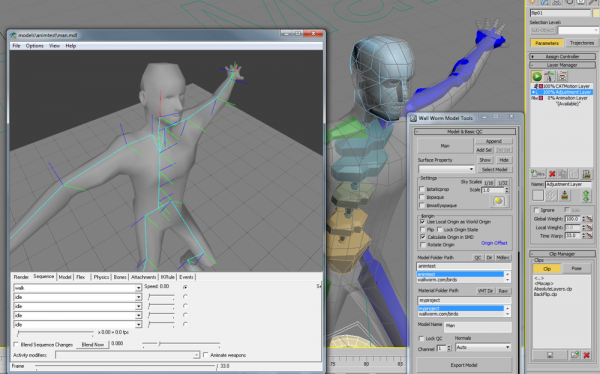Exporting CAT and Biped Models
NOTE: the SMD Exporter is only guaranteed to work with Skinned models in 3ds Max 2014+. In older versions of Max, the vertex weighting is sometimes incorrect.
You can now use Wall Worm to export your models that have been animated with CAT or Biped. This page discusses the general process of setting up your rig, setting up WWMT and exporting into Source. This page requires WWMT 1.95+.
Preparation
The following sections describe the preparation for rigging your character with CAT/Biped with exporting to Source in mind. It explains general principles as well as things specific to CAT or Biped.
General Rules
These are some general rules you should always follow when setting up your rig. Some of these may change over time, but as of right now, this is how it should work.
- Any Geometry object (the model) should have its transformation reset before you apply your skin modifier. You can do this with the Hierarchy Tab by clicking Reset Transform and Reset Scale (which you should try first on skinned meshes). You can also apply an XForm modifier to your model and then collapse to Editable Poly (or Editable Mesh)--which is the preferred step for static props. For more information, see My Model Scale is Wrong.
- When using the Skin modifier, you should limit the number of bones that can affect a vertex to the appropriate number for the engine you are using. While the Valve documentation on this is sparse, it appears that the general limitation is 3 or 4 bones per vertex. To make sure that your model matches this, open the Advanced Parameters rollout in the Skin modifier and set the Bone Affect Limit to that appropriate for your target engine/mod before you start skinning your model.
- As a general rule for character models, you should always align your model's root mesh to the world origin (at [0,0,0]), especially for the reference frame. When using WWMT, the reference frame is hard-coded to frame 0.
CAT-specific considerations
These rules should be followed for the CAT rigging.
- Do not add the various helper objects in a CAT system to the Skin. For example, the root CAT Parent object. You may get odd results if you add them.
Setting Up WWMT
Once your model has been rigged and animated, you can quickly send it to Source with WWMT.
- Open WWMT (Wall Worm > Wall Worm Model Tools > Wall Worm Model Tools).
- Click the Pick Model button.
- If you have not previously created a WWMT helper for your model, pick the main mesh; if you have already done this, pick the WWMT helper for this model.
- Uncheck $staticprop and Rotate Origin.
- Create an entry for each Sequence you need for the model in the Sequences tab.
- Make sure Steam is running.
- Click Export Model and wait for the exporter to finish and the compiler to run.
Validating the Export
Once the export has finished and the compiler is done, you can open your model in the Source Model Viewer. You should make sure that the bones are properly aligned by clicking the Bones checkbox in the render tab. If they are properly aligned, test your animation sequences in the Sequences tab. You can select a sequence in a drop-down menu and move the time slider to see the animation.
- As of WWMT 1.95+, proper skin weighting is not always guaranteed with 3ds Max 2013 and older. You should use 3ds Max 2014+.
Moving Further
I will flesh out this documentation as I get time. I do intend to add complete support for attaching the flexed head and special eyes. For the moment, you must manually edit the QC to compile the flexed head if your model has a head. You should use the special QCI file alongside your model's QC file to make those includes because WW will not overwrite the QCI file. To edit this, click the QCI button inside the WWMT UI or in the modify tab when you have the WWMT Helper selected.
Need Character Meshes?
If you need a character mesh, there is a really great free resource called MakeHuman. You can parametrically generate character meshes and export as FBX.
- Character Models
Articles related to making character models for the Source Game Engine.
- Exporting CAT and Biped Models
- Making Facial Animations
- Advanced Bone Settings
- Related Topics






